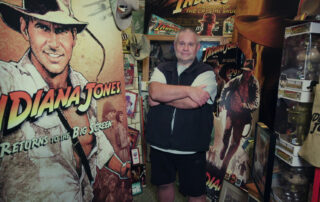Deke Slayton had the heart of a warrior. The native of Sparta was just 19 when he earned his pilot’s wings during World War II. He flew 56 combat missions in B-25 Mitchell bombers in the skies over Europe before returning to the U.S. to train bomber pilots. Then he was sent to the Pacific to fly more combat missions over Japan before the war ended.
While Deke was at Edwards Air Force Base working as a test pilot the Soviets launched Sputnik, a small shiny satellite that scared the bejesus out of Americans and started the space race. Soon Deke was among more than 100 test pilots competing to become America’s first astronauts. And when the first seven silver spacesuit-clad men were named – Deke Slayton was among them.
At the Mercury 7’s first press conference, Deke, with a crewcut and bowtie, sat next to Alan Shepard as America’s new heroes nervously answered questions. When a journalist asked the seven who wanted to be the first in space, Deke raised his hand. So did the other six astronauts.
Alan Shepard flew first, followed by Gus Grissom and John Glenn. Deke’s name was penciled in for the fourth mission to orbit Earth three times. But by the time the Mercury-Atlas rocket lifted off in 1962, Deke was watching from terra firma. A routine physical showed he suffered from an erratic heart beat. NASA doctors worried he could have a heart attack in space.
For a guy whose heart was strong enough to fly through enemy flak,strong enough to fly experimental jets, and strong enough to undergo grueling astronaut training, it was a bitter disappointment. Deke could have quit the space program. He could have gotten a lucrative job in private industry. But he refused to give up on his dream of one day flying in space.
So he gave up cigarettes and coffee, cut back on alcohol, swallowed vitamins and exercised daily. And he turned his energies to his new role as the powerful and influential director of flight crew operations during the Gemini and Apollo programs. The man who wasn’t allowed to travel in space became the guy who decided which astronauts got to go. It was Deke who chose Neil Armstrong to be the first man on the moon.
Deke’s story has a happy ending. Eventually his heart returned to normal and he was restored to flight status. In 1975 Deke finally blasted into space as the docking module pilot for the Apollo-Soyuz Test Project, linking up with a Soviet space ship. He spent more than nine days orbiting the pale blue marble of Earth on the last Apollo flight.
Deke Slayton isn’t as well known as the rest of America’s first astronauts but he did outlast them in one sense. Deke spent 23 years at NASA and holds the record as America’s longest-serving astronaut.








